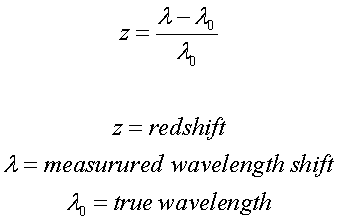

A gravitational redshift can also equivalently be interpreted as gravitational time dilation at the source of the radiation: if two oscillators (attached to transmitters producing electromagnetic radiation) are operating at different gravitational potentials, the oscillator at the higher gravitational potential (farther from the attracting body) will seem to ‘tick’ faster that is, when observed from the same location, it will have a higher measured frequency than the oscillator at the lower gravitational potential (closer to the attracting body). Gravitational redshift can be interpreted as a consequence of the equivalence principle (that gravity and acceleration are equivalent and the redshift is caused by the Doppler effect) or as a consequence of the mass-energy equivalence and conservation of energy ('falling' photons gain energy), though there are numerous subtleties that complicate a rigorous derivation.
#REDSHIFT EQUATION Z FULL#
The effect was first described by Einstein in 1907, eight years before his publication of the full theory of relativity. The opposite effect, in which photons (seem to) gain energy when travelling into a gravitational well, is known as a gravitational blueshift (a type of blueshift). This loss of energy corresponds to a decrease in the wave frequency and increase in the wavelength, known more generally as a redshift. In physics and general relativity, gravitational redshift (known as Einstein shift in older literature) is the phenomenon that electromagnetic waves or photons travelling out of a gravitational well (seem to) lose energy. The effect is greatly exaggerated in this diagram. The gravitational redshift of a light wave as it moves upwards against a gravitational field (produced by the yellow star below).


 0 kommentar(er)
0 kommentar(er)
